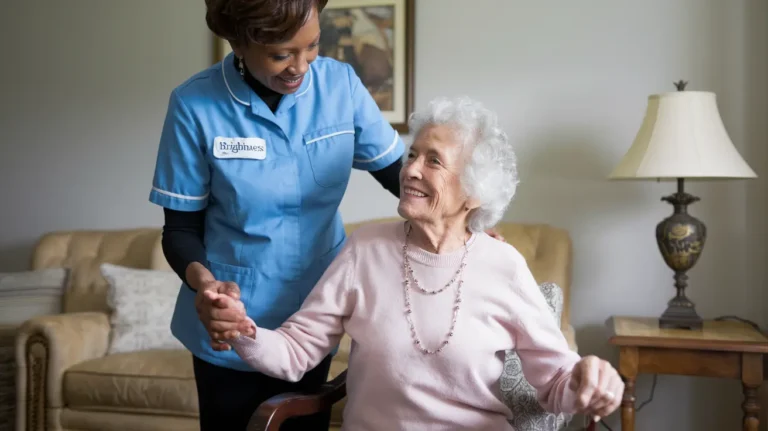In-Home vs Facility Respite Care: Finding the Right Solution in Indianapolis
Did you know that over 40% of family caregivers report high levels of emotional stress that can lead to burnout? I’ve seen it firsthand – that exhausted look in a caregiver’s eyes when they’re running on empty but feel guilty about taking a break. That’s where respite care comes in! It’s like a life preserver for drowning caregivers, offering temporary relief so they can recharge while ensuring their loved ones receive quality care.
Choosing between in-home and facility respite care isn’t easy, trust me. When I first had to make this decision for my uncle, I was completely overwhelmed by the options. Each family’s situation is unique, and what works for one might not work for another. Here in Indianapolis, families are fortunate to have several options, including our team at Brightness Home Care LLC, located at 4911 West 38th Street.
I’ve spent years helping Indianapolis families navigate this exact choice, and I’ve learned that understanding the fundamental differences between these two approaches is crucial for making the right decision for your loved one and yourself. Let’s explore what makes each option special and how to determine which might be the best fit for your family’s needs.
Understanding Respite Care Fundamentals
Respite care saved my sanity when I was caring for my mother with Alzheimer’s. Simply put, it’s temporary care provided to a dependent person, giving their regular caregiver a much-needed break. Many folks I’ve worked with don’t realize they need respite until they’re already burned out! Watch for warning signs like increased irritability, sleep problems, or feeling constantly exhausted – these were my personal red flags.
In Indianapolis, we’re lucky to have different flavors of respite care. You’ve got in-home services (my personal favorite for most situations), adult day centers, residential facilities, and even volunteer programs through churches. The timeframe can vary wildly too – some families just need a few hours weekly, while others might need several days or even weeks for a vacation or medical recovery.
The beauty of respite care isn’t just that it helps the caregiver – though goodness knows we need it! It also benefits the care recipient. I remember Mr. Johnson, whose wife came to us for in-home respite. He initially resisted “having strangers in the house,” but ended up loving his respite caregiver’s fresh energy and different conversation topics. Sometimes a new face is exactly what everyone needs!
Many caregivers struggle with guilt about taking time away, and I get it. I felt terrible leaving mom with someone else at first. But here’s what I learned the hard way: without proper breaks, you risk your own health and ultimately compromise the quality of care you provide. It’s like that airplane oxygen mask thing – you’ve gotta put yours on first before helping others. Respite isn’t a luxury; it’s an essential part of sustainable caregiving.
In-Home Respite Care: Comfort in Familiar Surroundings
In-home respite care brings qualified caregivers right to your doorstep, allowing your loved one to stay in their comfort zone while you take a breather. I can’t tell you how many families I’ve seen blossom once they discover this option! There’s something magical about maintaining routine in familiar surroundings, especially for folks with dementia or cognitive issues.
The biggest advantage? Your loved one doesn’t have to adjust to new environments, which can be really disorienting. My aunt Clara would get terribly confused when moved to new places, but thrived with in-home respite. Plus, there’s the one-on-one attention factor – your family member isn’t competing with others for care and attention.
In-home services through Brightness Home Care LLC typically include personal care (bathing, dressing, toileting), medication reminders, meal prep, light housekeeping, and the companionship that’s so crucial for emotional wellbeing. We’ve had clients who initially just wanted basic care but were thrilled to discover their respite caregiver shared interests in gardening or classic movies!
Cost-wise, in-home respite in Indianapolis generally runs between $25-35 per hour, though it varies based on care needs and schedule. Nights and weekends might cost a bit more – learned that lesson when planning my sister’s weekend getaway! Many families don’t realize that long-term care insurance sometimes covers respite services, and there are occasional grant programs available through caregiver organizations.
At Brightness Home Care, we’re not about cookie-cutter care plans. Every family gets a thorough assessment to understand specific needs, routines, and preferences. I remember creating a plan for Mr. Santiago who had very specific routines – his respite caregiver needed to know exactly how he liked his coffee and which chair was “his” for watching the news. These details matter!
Our caregivers undergo rigorous background checks and training, including specialized education for conditions like dementia, Parkinson’s, and post-stroke care. I personally wouldn’t let anyone care for my family without this kind of preparation, and neither should you. The peace of mind from knowing your loved one is with a qualified professional is absolutely priceless.
Facility-Based Respite Care Options in Indianapolis
Facility respite care gives your loved one a change of scenery while providing care in a structured environment. Indianapolis has several options – nursing homes, assisted living communities, and dedicated respite centers. I toured a bunch of them last year when researching options for a client, and was impressed by how much they’ve improved over the years!
The facility environment shines for certain situations. I remember when Mrs. Williams needed post-surgery respite care requiring specialized equipment and 24/7 nursing. A facility made more sense than trying to recreate that level of care at home. Facilities also work well for longer respite periods or when medical needs are complex.
One of the coolest things about facility respite is the social aspect. I’ve had several clients who were initially reluctant but ended up loving the activities and making new friends! Mr. Peterson was super shy and homebound for years until his facility respite stay introduced him to a group of veterans who shared his experiences. It transformed his outlook completely.
Cost structures for facility respite in Indianapolis typically range from $150-300 per day, depending on the level of care needed and amenities offered. Most require a minimum stay (typically 5-7 days), which caught me off guard when planning for my first client. Some facilities offer “respite apartments” that feel more homelike than traditional rooms, though they usually book up quickly.
I’ve found that facility respite works particularly well for seniors who thrive on routine and structured activities. One gentleman with early dementia actually showed improvement during his facility stay because of the consistent schedule and cognitive stimulation activities. His family was shocked (in a good way)!
That said, facilities aren’t for everyone. I had one client with severe anxiety who found the facility environment overwhelming, despite the staff’s best efforts. It’s so important to consider your loved one’s personality and preferences when making this choice.
Making the Right Choice: Factors to Consider
Choosing the right respite option starts with an honest assessment of care needs. I made the mistake once of arranging basic in-home respite for a client with complex medical needs – it was a disaster! Be realistic about required care levels, especially regarding mobility assistance, medication management, and specialized care for conditions like dementia.
Don’t forget to consider your needs as a caregiver too! What kind of break do you actually need? A few hours for errands and appointments? A weekend getaway? A longer vacation? I’ve worked with caregivers who felt guilty for wanting a real break, but self-care isn’t selfish – it’s necessary for sustainable caregiving.
Financial considerations play a huge role too. I learned the hard way that Medicare has very limited respite coverage (basically only for hospice situations). Long-term care insurance might help, and some families qualify for Medicaid waiver programs. At Brightness Home Care, we try to work with families to find affordable solutions, sometimes suggesting shorter but more frequent respite sessions to manage costs.
Flexibility matters tremendously in respite care. Life happens! Your plans might change, or emergencies arise. In my experience, in-home providers like us at Brightness Home Care typically offer more scheduling flexibility than facilities, which often require advance booking and minimum stays. I remember scrambling to arrange last-minute respite when a caregiver had a family emergency – having flexible options saved the day.
When considering specialized needs, be super specific about requirements. My brother has dietary restrictions that weren’t properly communicated during his respite stay, resulting in some uncomfortable days. Create detailed care plans covering medications, routines, preferences, triggers for those with dementia, and emergency contacts. I always recommend a trial run for a few hours before longer respite periods – it helps everyone adjust and identify potential issues.
Brightness Home Care’s Approach to In-Home Respite
At Brightness Home Care, our respite philosophy centers on maintaining normalcy while providing excellent care. After years in this field, I’ve learned that preserving routine reduces stress for everyone involved. When Mrs. Johnson needed respite care for her husband with Parkinson’s, we spent hours understanding his exact daily schedule – down to which coffee mug he preferred and what time he liked his afternoon walk.
Our assessment process goes beyond basic care needs. We look at personality matches too! I remember pairing a respite client who was a retired history teacher with a caregiver who shared that interest. Their respite visits turned into fascinating discussions about historical events that stimulated the client cognitively while giving his wife much-needed breaks.
The matching process is something I take tremendous pride in. We consider care requirements first, obviously, but also personality, interests, and communication styles. This attention to compatibility makes such a difference! I’ve seen initially reluctant care recipients actually look forward to their respite caregiver’s visits because they’ve developed a genuine connection.
Our respite services cover everything from basic companionship to complex care. Need someone to just be present and ensure safety? We’ve got you. Need help with bathing, transferring, medication management, and meal prep? Absolutely covered. I’ve even arranged for respite caregivers to accompany clients to favorite activities or religious services when family couldn’t.
Our West Indianapolis location gives us quick access to families throughout the metro area, and we pride ourselves on responsiveness. I remember getting a desperate call from a caregiver whose parent had fallen, requiring her immediate attention – but she had young children to care for. We arranged same-day respite care that solved both problems at once. That kind of flexibility makes all the difference during stressful times!
Transitioning to Respite Care: Tips for Success
Transitioning to respite care can be emotional for everyone involved. I learned this firsthand when introducing respite care for my aunt – she was resistant and I felt guilty. Start preparing your loved one early by discussing the concept positively, emphasizing the benefits and temporary nature. One family I worked with created a simple photo book of the respite caregiver to review beforehand, which helped tremendously with their mother’s anxiety.
Creating detailed care instructions is crucial! I once forgot to mention a client’s afternoon nap routine to a new respite caregiver, resulting in an overtired and cranky evening for everyone. Document everything – medications, food preferences, daily routines, favorite activities, and potential triggers for upset. One smart family created a one-page “cheat sheet” with the most essential information that their respite caregivers really appreciated.
Expect some adjustment bumps! Almost every family I’ve worked with reports some hiccups during initial respite experiences. Your loved one might exhibit some resistance or behavioral changes. This doesn’t mean respite isn’t working – it’s just part of adapting to something new. I usually recommend starting with shorter sessions and gradually increasing duration as comfort grows.
Communication is absolutely key to successful respite. At Brightness Home Care, we implement care journals where respite caregivers document the day’s activities, mood changes, and any concerns. This creates continuity between different caregivers and helps family members stay informed. I’ve seen such relief on caregivers’ faces when they return from a break to find detailed notes about their loved one’s day!
Consider what success looks like for your situation. For some families, it’s simply getting a break without constant worry. For others, it’s seeing their loved one actually enjoy the respite experience. I worked with one daughter who considered it a win when her mother stopped calling her every hour during respite visits – a sign she was finally comfortable with her caregiver!
Conclusion
Choosing between in-home and facility respite care comes down to understanding your unique situation. After helping countless Indianapolis families navigate this decision, I’ve seen how in-home care preserves comfort and routine, while facility care offers structure and socialization. Both have their place in the caregiving journey!
Taking regular breaks through respite care isn’t just nice – it’s absolutely essential for sustainable caregiving. I’ve seen too many caregivers reach complete burnout before finally accepting help. Please don’t wait until you’re at your breaking point! Small, regular respite breaks can prevent caregiver burnout and actually improve the quality of care you provide.
At Brightness Home Care LLC, we understand the challenges Indianapolis caregivers face. Our West 38th Street location serves families throughout the area with personalized, compassionate respite care that honors both the caregiver’s need for a break and the care recipient’s need for consistency and dignity. Every family’s situation is unique, and we’re committed to finding the right respite solution for yours.
I encourage you to reach out for a consultation to discuss your specific needs – sometimes just talking through options with a professional can provide clarity and relief. Taking that first step toward respite care might feel difficult, but I promise it’s worth it. Your well-being matters too!
Have questions about respite care options or want to share your own experiences? We’d love to hear from you! Contact Brightness Home Care LLC today to learn how we can support your caregiving journey with professional, compassionate respite services designed around your family’s unique needs.







